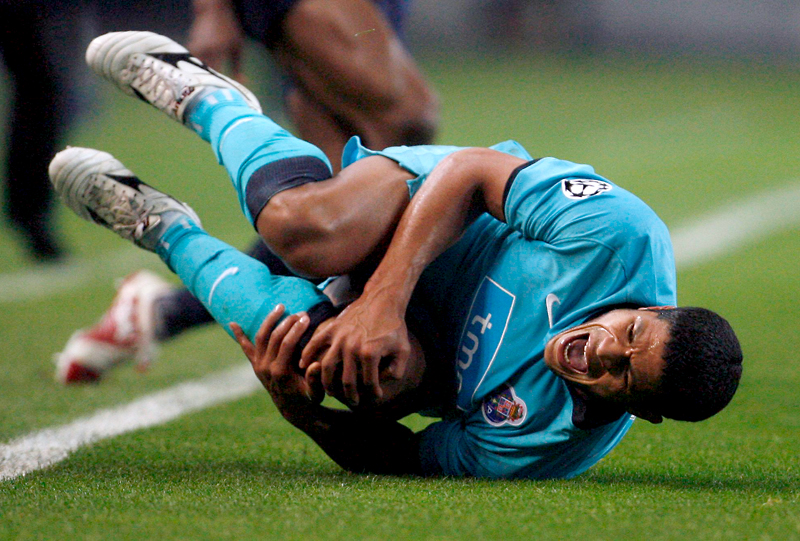You are viewing 1 of your 1 free articles. For unlimited access take a risk-free trial
Hamstring injuries: treatment and prevention
John Munroe explains how to deal with a hamstring strain
Your hamstrings can be prone to strain, as many of you will know through painful, personal experience. This will especially be the case if you are involved in a dynamic sport that requires, for example, sprinting and kicking. However, the great news is that a relevant stretching and strengthening programme can reduce strain to a minimum.Hamstring strains often occur from fast sprinting and kicking movements as the muscle tries to arrest the movement of the lower leg as it dynamically travels away from the body. This ‘stretch as it contracts’ movement is known as an eccentric contraction. Fatigue can also be a big contributor to hamstring strain. Research from football and rugby indicates that most occur during the final quarter of a match. This means that you should progressively develop your sport-specific condition so that you can handle the loadings and repetitions required of your sport.
Could a strain actually be nerve pain?
You may think you have ‘strained’ your hamstring but are still able to run – why is this? This could be a neural response as ‘erroneous pain messages’ are sent to your hamstrings from the lumber spine. Here’s a test to see if this is the case:-
Slump test
Sit on the edge of a high platform, put your hands behind your back and don’t let your feet touch the floor. Tilt your head forward and lift one leg towards the mid-line of your body pulling your leg up and down a few times.
If you experience a burning sensation around the hamstring region this could indicate nerve pain. -
Passive hamstring stretch
Lie on your back and lift one leg from the floor. Keeping it straight pull it towards you ensuring that there is a full range of movement on the stretch. If there is pain in your hamstrings then it is likely to be caused by your nerves.
If you have a hamstring strain what do you do?
Muscle strains are graded from 1-3. A grade 3 results in a full rupture of muscle fibres; a grade 1 micro tears.Symptoms of hamstring strain
- When you perform a sports skill you experience sudden pain in your hamstrings.
- There is pain when walking or jogging.
- You cannot stretch the hamstring.
- There is a continuous dull ache in the area.
- There is bruising or swelling.
- It is tender to touch.
Step 1
TreatmentFollow the RICE principles for the first 48-72 hours:
Rest - prevents further damage and quick healing process.
Ice - reduces swelling. Ice 12 minutes every 2 hours.
Compression - reduces swelling – use a tubigrip or bandage.
Elevation - reduces swelling and drains fluid away from area.
Step 2
Thereafter, depending on any swelling, soft tissue massage may be applied 3-4 times a week. Allow a day between treatments. You must still ice for 12 minutes every 2 hours during this process. The massage can be done either by a sports masseur or physiotherapist. You should also stretch other muscle groups around the hamstrings, such as the quadriceps. You should also lightly stretch the hamstrings – of which more later.Step 3
Progress to more sport-specific movements. You could, for example, begin with some low intensity runs on grass at half pace over 60 metres repeated 4 times with a walk back recovery. As the days pass, progress the distance up to 100 metres, again using a walk back recovery. Progress to 6 runs but maintain the same speed.Once you have done a week’s worth of rehabilitation and have not suffered from any adverse effects, from the following week you can gradually increase your speed. You should look to return to normal training at the end of week 2/start of week 3 (obviously this will depend on the type of strain you sustained – if in doubt always consult an expert).
Stretches
I have provided examples of different types of hamstring stretches:Nerve stretching
A nerve stretch is slightly different to a muscle stretch although the movement can be similar.To ‘nerve stretch’ you hold a stretched position and then move from the closest joint.
- Hamstring nerve stretch 1
Sit on the floor with your feet against a wall and your hands behind the back of your head. Gently pull your head forward until you experience slight tension in the back of your legs and/or lower and upper back.
Hold for 20-30 seconds. Repeat 3 times.
Do not pull on your head. - Hamstring nerve stretch 2
Sit on a chair with a table positioned in front of you. Slump into the chair and place one hand behind your back and the other on the back of your head. Position one leg on the table and keep it straight. Gently bend forward at your hips until there is slight tension in your hamstrings, hold for 20-30 seconds on each leg, then release gently.
‘Normal’ passive hamstring stretches
These passive stretches do no involve dynamic movement – they specifically elongate the hamstring muscle:- Seated stretch
Sit on the floor with one leg stretched out in front of you. Place the sole of your other leg against the knee of the outstretched leg. Lean forward from your hips; keep your back straight until there is tension in the hamstring.
Hold for 30 seconds. Repeat 3 times on each leg. - Lying hamstring stretch
Lie on your back with one leg pressed into the floor the other raised in the air (maintain a slight bend at the knee). Place a towel around the sole of your shoe on your raised leg and pull your leg towards the midline of your body until you feel tension.
Hold for 30 seconds. Repeat three times on each leg.
Active hamstring stretches
These stretches involve movement and will specifically stretch the muscles through movements that will occur in numerous dynamic sports:- Leg swings
Stand tall and swing one leg forwards and backwards. Keep your body upright. - Leg cycling
Stand tall and cycle one leg under your body in a sprinting-type movement.
How to strengthen your hamstrings
There are numerous hamstring strengthening exercises, such as squats and lunges, and, of course, leg curls. I have, however, provided you with a slightly more unusual but very effective example.Fit ball hamstring lift
Lie on your back and place your lower legs on the fit ball. Place your arms flat down on the floor with your hands 70-80cm away from your hips to aid your balance. Lift your hips off the ground. Pull the fit ball in towards your butt with your heels and then push it away. Repeat the movement, maintaining control. Do 3 x 10 repetitions. To progress the exercise perform the same movement with one leg.Fit ball hamstring lift - Step 1
Fit ball hamstring lift - Step 2
Develop strength with balance
During sports activities the hamstrings (and your other muscles) will often be contracting while you are off balance. The hamstrings are designed to react quicker than your quadriceps to control movement and provide stability while doing an activity. If there are imbalances strains can occur. To help avoid this you should perform sport-specific drills and practices. However, you can also do specialised exercises.Single-leg stand
Stand on a pillow on one leg, with your eyes closed. Try to balance without falling. Start with 5 seconds and progress to longer holds.Repeat exercises in sets of 10 on both legs.
John Munroe
John has worked in the fitness industry for 12 years as a top personal trainer and coach. He is also a physiotherapist TI at Guys and St Thomas’ Hospital in London.
John is an ex-international long jumper, who still competes at masters level. He is currently (M35) European gold medallist and has silver and bronze medals from prior World Championships.
He can be contacted on 0771 872 7771 for coaching and personal training and injury management.
NOTE: Please consult a doctor or physiotherapist if you are concerned about any injury.
Newsletter Sign Up
Testimonials
Dr. Alexandra Fandetti-Robin, Back & Body Chiropractic
Elspeth Cowell MSCh DpodM SRCh HCPC reg
William Hunter, Nuffield Health
Newsletter Sign Up
Coaches Testimonials
Dr. Alexandra Fandetti-Robin, Back & Body Chiropractic
Elspeth Cowell MSCh DpodM SRCh HCPC reg
William Hunter, Nuffield Health
Keep up with latest sports science research and apply it to maximize performance
Today you have the chance to join a group of athletes, and sports coaches/trainers who all have something special in common...
They use the latest research to improve performance for themselves and their clients - both athletes and sports teams - with help from global specialists in the fields of sports science, sports medicine and sports psychology.
They do this by reading Sports Performance Bulletin, an easy-to-digest but serious-minded journal dedicated to high performance sports. SPB offers a wealth of information and insight into the latest research, in an easily-accessible and understood format, along with a wealth of practical recommendations.
*includes 3 coaching manuals
Get Inspired
All the latest techniques and approaches
Sports Performance Bulletin helps dedicated endurance athletes improve their performance. Sense-checking the latest sports science research, and sourcing evidence and case studies to support findings, Sports Performance Bulletin turns proven insights into easily digestible practical advice. Supporting athletes, coaches and professionals who wish to ensure their guidance and programmes are kept right up to date and based on credible science.









